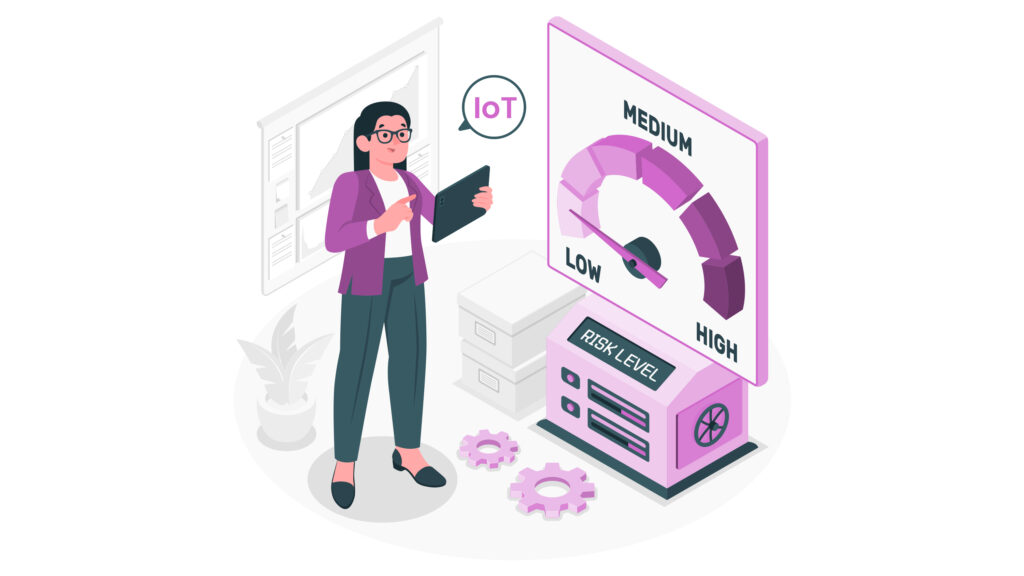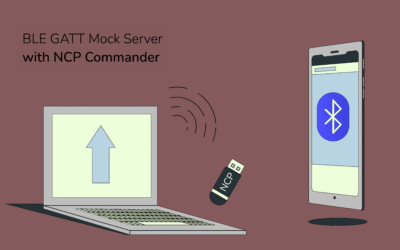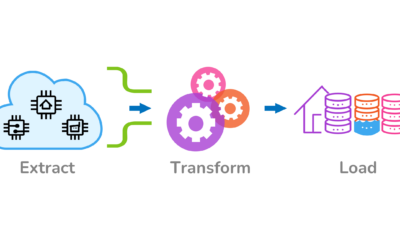Table of Content
- IoT Cybersecurity and Data Privacy
- Considerations for Managing IoT Device Security Risks
- IoT Cybersecurity Risk Mitigation Goals
- IoT Device Expectations and Organizational Implications
- Overcoming IoT Device Security Challenges
- Strategies for Managing the IoT Device Security Risks
- Risk Mitigation in Practice
- Building Secure IoT Devices with Krasamo
The transformative potential of IoT comes with associated risks that emphasize the need for organizations to embrace IoT device security challenges and craft risk management strategies.
Organizations must understand the unique risks affecting IoT devices and the steps to manage these risks. This requires developing a security mindset, gradually adjusting the organization’s processes, and implementing risk mitigation practices throughout the IoT device lifecycle.
IoT devices have the capabilities to interact with other devices and the physical world, but these interactions typically affect the supporting security and privacy capabilities in specific contexts.
IoT Cybersecurity and Data Privacy
IoT devices operate within ecosystems that are susceptible to cybersecurity risks or threats. These threats exploit the inherent vulnerabilities of these devices. Given the vast amounts of data generated and processed by IoT devices, understanding the importance of their cybersecurity is paramount.
As IoT developers, we get involved in the design process of IoT devices, recognize cybersecurity risks, and incorporate mitigation strategies during the development phase. Because IoT devices interact with the real world, they face unique challenges. These risks can influence the system’s behavior and data processing mechanisms.
To manage these risks effectively, organizations must evaluate the nature of potential threats, assess their likelihood, and understand the possible impact on IoT devices and their operational environments.
Considerations for Managing IoT Device Security Risks
Understanding the unique characteristics and challenges of Iot devices is critical in shaping risk mitigation goals and influencing the management of IoT cybersecurity and privacy risks. These lay the foundation for crafting robust and effective risk management strategies.
Interactions with the Physical World
Data received from IoT sensors must be properly managed to mitigate the risk of attacks. Such attacks could alter the data, resulting in erroneous readings and potentially leading to incorrect decisions. Also, collecting data about individuals requires security to avoid activities or disclosing data in unintended ways that compromise and complicates privacy and confidentiality.
Attackers could access physical systems through IoT devices that use actuators and remotely make changes that could endanger the safety of humans, equipment or disrupt operations.
Due to their operation in unconventional settings, compared to traditional IT devices, or in remote locations with limited connectivity, IoT devices often pose challenges in updating software or firmware and applying automatic patches. This makes them vulnerable to exploitation.
IoT Device Accessing, Monitoring, and Management Features
Typically, IoT devices are difficult to access, manage, and monitor. They often provide limited visibility into their state, composition, and the services interacting with them, which makes configuration challenging. This lack of transparency complicates management and monitoring, consequently increasing security risks.
Securing IoT devices can be complex and challenging. These devices often have limited functionality for managing software operations and suffer from a lack of standardized interfaces, resulting in interoperability issues.
Securing IoT devices can be complex and challenging. These devices often have limited IoT device security functionalities for managing software operations, leading to interoperability issues.
IoT device operations may be further complicated by the absence of centralized management mechanisms, software types (including firmware, operating systems, real-time operating systems, and applications), and inconsistent manufacturer support. Additionally, difficulties in tracking and inventorying these devices add another layer of complexity.
Available Cybersecurity and Privacy Capabilities
Considering IoT devices’ cybersecurity and privacy capabilities is essential to manage risks. The manufacturer designs built-in capabilities that may not be robust enough or support a full range of cybersecurity and privacy measures.
There are also capabilities implemented by organizations to meet the needs of IoT devices in operation. Sometimes the context and environments of the IoT operation are challenging to protect many devices simultaneously. For example, there might be different devices using various communication protocols.
As IoT developers, we work with clients to ensure they develop strong capabilities to support their devices and their users. Learn more about Incorporating IoT Cybersecurity Capabilities in Product Development.
IoT Cybersecurity Risk Mitigation Goals
Mitigation areas focus on specific strategies or steps to address and manage associated risks. These are action points or measures to reduce the likelihood or impact of an unwanted event or risk.
Some risk mitigation areas or aspects related to these goals are asset management, vulnerability, data protection, vulnerability management, information flow management, data permissions, privacy breach detection, etc.
- Device Security
Device security involves safeguarding a device from exploitation in harmful activities, such as being manipulated into spreading malware to other devices, being used as a gateway for unauthorized access to the network, or becoming a platform for data theft or ransomware attacks. This goal is universally relevant for all IoT devices.
- Data Security
Ensure information safety. Safeguard the confidentiality, accuracy, and accessibility of information (including Personally Identifiable Information) gathered, held, managed, or shared by the IoT device.
- User Privacy
User privacy goals involve safeguarding the privacy of personal information handled beyond the IoT device or data security practices.
These goals help to create a comprehensive approach to managing IoT security and privacy risks. Failing to address cybersecurity risks adequately leads to serious consequences, including device compromise, data breaches, harm to individuals’ privacy, and damage to the reputation of the organizations deploying IoT devices.
IoT Device Expectations and Organizational Implications
For IoT developers, it is essential to understand how the organization expects to mitigate the risks based on their goals. Expectations set the standard or baseline, representing the desired state or output, often defined by stakeholders, management, or external entities like regulators. The following are examples of expectations based on IoT device goals:
Goals and Expectations:
1. Device Identification and Authentication:
- Built-in unique identifier for the device.
- Interface with enterprise asset management systems.
- Authenticate each user, device, and process attempting logical access.
- Use existing enterprise authenticators and authentication mechanisms.
- Conceal password characters during input.
- Uniquely identify each user, device, and process for logical access.
2. Access Control:
- Restrict each user, device, and process to minimum logical access privileges.
- Thwart attempts to gain unauthorized access (configurable).
- Prevent unauthorized access to sensitive data on storage devices.
- Prevent unauthorized access to transmitted sensitive data.
- Operate within a federated identity environment.
3. Physical Security:
- Built-in physical security controls against tampering (e.g., tamper-resistant packaging).
4. Event Logging and Monitoring:
- Log operational and security events.
- Interface with existing enterprise log management systems.
- Facilitate detection of potential incidents through internal/external controls.
- Support event and incident analysis activities.
5. Patch and Vulnerability Management:
- Manufacturer’s commitment to provide patches/upgrades throughout the device’s lifespan.
- Secure built-in patch, upgrade, and configuration management capabilities OR interface with enterprise vulnerability systems.
- Support built-in vulnerability identification and reporting capabilities.
6. Data Integrity and Availability:
- Mechanism to support data availability through secure backups.
7. Transparency and Visibility:
- Provide visibility into device characteristics.
- Inform organizations of external software and services the device uses.
8. Privacy and Data Management:
- Sufficient centralized control for applying data policies.
- Sufficient centralized control to manage confidential data.
- Traditional interfaces for engagement with the IoT device.
Implications for the Organization (Challenges if the above goals are not met):
- Increased likelihood of eavesdropping, malicious activities, tampering, and data loss.
- Delays in threat detection and response.
- Inability to confirm and reconstruct incidents.
- Complications in device management, patching, and risk assessment.
- Compliance risks with regulatory requirements and organizational policies.
- Difficulty in managing and tracking PII.
- Problems for individuals due to inaccurate or unavailable PII.
By following the above goals and expectations, organizations can substantially reduce their exposure to potential device risks and enhance their security and privacy posture.
Overcoming IoT Device Security Challenges
IoT developers, while considering these risks and setting security goals, face the challenging task of creating robust and secure products. How these risks are considered during product development plays a crucial role in anticipating potential challenges.
Risk considerations shape the management of IoT device security risks and assist in formulating effective risk mitigation goals relevant to the IoT device, its associated data, and user privacy.
The anticipation and approach of organizations toward risk mitigation can also lead to identifying potential challenges.
The challenges of achieving these goals are multifaceted and depend largely on the specific use case, expectations, organizational requirements, and the adopted mitigation practices. However, a comprehensive discussion of these challenges and their potential implications for the organization lies beyond the scope of this paper.
The following are some examples of key challenges associated with IoT device security:
Authentication and Identification:
- Inability to identify or authenticate users, devices, and processes.
- Lack of capability to support configurations like remote activation prevention and data minimization.
- Inadequate concealment of displayed password characters.
- No support for standardized mechanisms for centralized data management.
- Absence of unique identifiers for asset management.
- Not supporting the use of existing enterprise user authentication systems.
- Limited support for strong credentials such as cryptographic tokens.
- Inability to verify the identity of other computing devices before sharing data.
Data Collection and Management:
- Issues with logging operational and security events in detail.
- Difficulty in traditional data management due to decentralized data processing and heterogeneous ownership.
- Challenges in data accuracy and deidentification processes.
- Complex and dynamic nature of devices that can frequently collect PII.
- Indiscriminate PII collection due to automated processes and heterogenous ownership.
- Potential lack of interfaces for reading privacy notices and accessing PII.
Security and Privacy:
- Remote accessibility leading to uncontrolled sharing of PII.
- Deployment in areas accessible by unauthorized individuals.
- Inability to execute internal and external detection controls without affecting device operation.
- Insufficient encryption capabilities for both stored and networked data.
- Lack of secure backup and restore mechanisms for data.
- Insufficient access for analysts to the device’s resources.
- Limitations in supporting non-trivial credentials and logical access privileges.
Maintenance and Upgrades:
- Issues in installing patches or upgrades without causing operational disruptions.
- Inability to participate in centralized asset, vulnerability, and log management systems.
- Potential of being a ‘black box’ with limited information on hardware, software, and firmware.
- Manufacturers are not releasing patches or upgrades or ceasing support while the device is still in use.
- Absence of vulnerability scanners compatible with the device.
General Challenges:
- Devices may contribute data for identification outside of traditional federated environments.
- Devices might lack mechanisms for sanitizing data before disposal.
- Challenges in detecting incidents due to visibility constraints.
Strategies for Managing the IoT Device Security Risks
To effectively manage the potential security risks associated with IoT devices, organizations should understand the inherent risk considerations and how they may influence their mitigation efforts. This understanding will form the foundation upon which other strategies are built:
- Policy and Process Adjustments: Once the risks are understood, modify organization policies and processes to address the specific challenges posed by IoT devices throughout their lifecycle. This includes updating existing risk mitigation practices to align with any changes in the IoT device environment.
- Clear Policy Definition: Clearly define the scope of IoT device security policies. This is crucial, especially when laws and regulations offer varying definitions. A clear policy ensures uniformity in interpretation and application.
- Incorporate IoT Considerations: Seamlessly integrate IoT considerations into broader organizational programs like cybersecurity, supply chain, and privacy risk management. This encompasses recognizing which devices fall under the IoT category, identifying their specific types and purposes, and continuously assessing their security profile.
Moreover, it’s imperative to recognize that while managing IoT device security, there may be unintended consequences affecting safety, reliability, and performance. Organizations must weigh the trade-offs between these risks and their mitigation strategies to make informed decisions.
Risk Mitigation in Practice
IoT devices can vary widely in functionality, from basic to complex, leading to different cybersecurity and privacy risks. The significant number and variety of IoT devices need a customized approach to risk mitigation compared to conventional IT devices.
The diverse functionality of IoT devices means there’s a wide range of IoT device security risks. Managing these risks requires a nuanced approach tailored to each device type and its intended use.
The intended use of an IoT device could determine its risk profile and, subsequently, the risk mitigation strategies.
Building Secure IoT Devices with Krasamo
Considering venturing into IoT product development? Dive into the realm of IoT with a trusted partner to ensure robust device security every step of the way.
With more than a decade developing IoT systems, Krasamo is uniquely positioned to guide you in building secure, reliable devices.
- Discuss IoT device security considerations, goals, risk mitigation, and challenges for IoT devices.
- Craft use cases that resonate with your target audience, ensuring their security needs are met.
- Pinpoint potential security vulnerabilities and fortify against them.
- Seamlessly integrate security features tailored to your offering.
- Navigate the complexities of the IoT security ecosystem with ease.
- Discuss IoT device security certifications.












I completely agree with your emphasis on robust security measures for IoT devices. However, I’d love to see more discussion on how these best practices can be integrated into a real-world IoT project through the lens of internet of things consulting – specifically, what kinds of tools or frameworks are most effective in implementing these protocols? Looking forward to hearing more!
I completely agree that robust security measures are essential for IoT devices! I think it would be super helpful to discuss how to integrate these best practices into a real-world project through the lens of IoT consulting services. Are there any specific tools or frameworks that have been effective in implementing these protocols? What experiences have others had with incorporating security measures into their IoT projects?
Oh boy, I’m so glad you brought this up! In my experience with IoT consulting companies, we’ve found that implementing robust security measures can be a real challenge. But there are some great tools out there, like secure firmware updates and data encryption. These have really helped us mitigate risks in our projects. Would love to hear more about your experiences!
Best,
I’m glad to see a strong emphasis on robust security measures for IoT devices. I’d love to hear more about real-world implementation through the lens of internet of things consulting. In the context of IoT device security, tools like OWASP ZAP or Burp Suite can be effective in implementing protocols and identifying vulnerabilities. A framework like NIST Cybersecurity Framework can also provide a structured approach to managing risks. Looking forward to hearing more!
Great feedback on emphasizing robust security measures for IoT devices! I’m excited to hear more about real-world implementation through an internet of things consulting lens. Thanks for sharing your thoughts on using OWASP ZAP, Burp Suite, and the NIST Cybersecurity Framework – can’t wait to dive deeper into iot device security!
I completely agree that integrating robust security measures into real-world IoT projects is crucial! For internet of things consulting, frameworks like DevSecOps and industrial control systems (ICS) cybersecurity standards are effective in implementing protocols. I’d love to hear more about this discussion!
I completely agree with your emphasis on robust security measures for IoT devices. For effective implementation, I’d recommend exploring frameworks such as NIST Cybersecurity Framework and IEC 62443, commonly used by top-tier IoT consulting companies. These guidelines provide a structured approach to risk assessment and mitigation.
While I appreciate the comprehensive list of IoT security risks, I feel that some points are overly broad and lack actionable solutions. A more nuanced approach is needed for internet of things consulting practices to effectively mitigate these challenges.
I completely agree with this comprehensive approach to managing IoT security and privacy risks! It’s crucial for organizations to prioritize these goals, especially when considering internet of things consulting services. Kudos to the author for breaking it down so clearly!
Hey there, I just finished reading your post on IoT device security and I gotta say, it’s a real eye opener! As an older guy who’s also studying comp sci, I can relate to the importance of this topic. One thing that stuck out to me is the lack of secure backup and restore mechanisms for data – something we should definitely be addressing ASAP, especially with all these IoT devices getting connected to our homes and businesses. Great job bringing this up! We gotta get serious about iot device security.